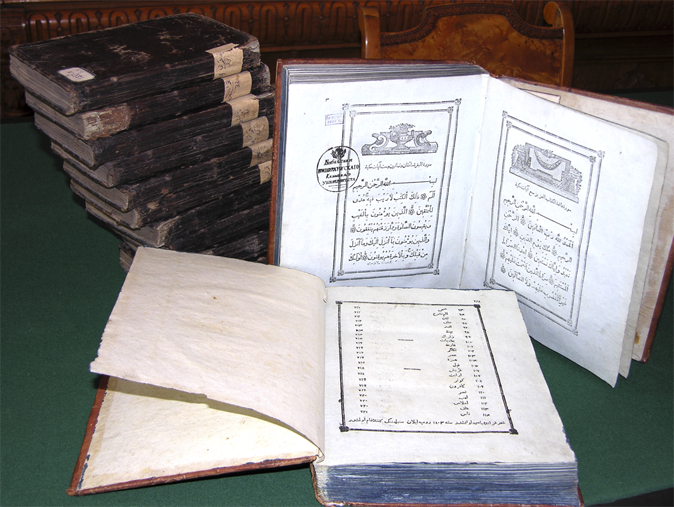Two-volume Kazan edition of the Quran published in 1803.
27.03.2025

Today our topic will be the Kazan edition of the Quran.
On October 20, 1800, a part of the Asian printing house with Arabic script
was transferred from St. Petersburg to Kazan. A few months later, the printing of
books in Arabic script was initiated.
In August 1803, with the highest permission of the Emperor Alexander I,
the full text of the Quran was printed in this printing house (in the building of the
local gymnasium). It was printed in an edition of 1,500 copies on the suggestion
and at the expense of its proprietor, retired officer Gabdelgaziz Burashev. The
Sacred Book was presented in two versions: in two volumes and in ten volumes
(for children). The photo illustrates both versions, which are archived in the
collection of the Scientific Library of Kazan Federal University.
Compared to earlier St. Petersburg editions, the text of the first Kazan
edition of the Quran was in compliance with the canonical principles of recording
the sacred book of Muslims (the so-called al-Rasm al-‘Usmani). Thus, the 1803
Kazan edition is regarded as the first complete edition of the canonical text of the
Quran in the Muslim world.
Kazan editions of the Quran were unmistakably distinguished due to artistic
presentation of books. The typesetting typical of European book printing prevailed
throughout the nineteenth century. One of the main features of the Kazan Quran
was the division of ayats (verses) into five-petaled rosettes.
The script of the Kazan editions is identical to the script of the St. Petersburg
editions of the Quran, as the same equipment was used. An important distinction of
the first Kazan edition from the St. Petersburg ones was the absence of marginal
commentary. Each page contained 11 lines.
The first and subsequent Kazan editions established the modern
printing standard for the Quran: framed text, numerical page numbering,
plainness of script and linearity of the printed text etc. They also
popularized the practice of including the “khatm” (prayer recited after the
Quranic recitation is completed) at the end of the book, information on the
signs of tajwid (rules for reading the Quran), and an index of surahs.
We hope to share more about the 1803 children’s edition of the Quran in the
forthcoming issue.
The first edition of 1803 was published in two versions: in two and ten volumes.
Scientific Library of Kazan (Volga Region) Federal University.
Materials are provided by the State Budgetary Institution Kazan
Kremlin Museum-Reserve.
On October 20, 1800, a part of the Asian printing house with Arabic script
was transferred from St. Petersburg to Kazan. A few months later, the printing of
books in Arabic script was initiated.
In August 1803, with the highest permission of the Emperor Alexander I,
the full text of the Quran was printed in this printing house (in the building of the
local gymnasium). It was printed in an edition of 1,500 copies on the suggestion
and at the expense of its proprietor, retired officer Gabdelgaziz Burashev. The
Sacred Book was presented in two versions: in two volumes and in ten volumes
(for children). The photo illustrates both versions, which are archived in the
collection of the Scientific Library of Kazan Federal University.
Compared to earlier St. Petersburg editions, the text of the first Kazan
edition of the Quran was in compliance with the canonical principles of recording
the sacred book of Muslims (the so-called al-Rasm al-‘Usmani). Thus, the 1803
Kazan edition is regarded as the first complete edition of the canonical text of the
Quran in the Muslim world.
Kazan editions of the Quran were unmistakably distinguished due to artistic
presentation of books. The typesetting typical of European book printing prevailed
throughout the nineteenth century. One of the main features of the Kazan Quran
was the division of ayats (verses) into five-petaled rosettes.
The script of the Kazan editions is identical to the script of the St. Petersburg
editions of the Quran, as the same equipment was used. An important distinction of
the first Kazan edition from the St. Petersburg ones was the absence of marginal
commentary. Each page contained 11 lines.
The first and subsequent Kazan editions established the modern
printing standard for the Quran: framed text, numerical page numbering,
plainness of script and linearity of the printed text etc. They also
popularized the practice of including the “khatm” (prayer recited after the
Quranic recitation is completed) at the end of the book, information on the
signs of tajwid (rules for reading the Quran), and an index of surahs.
We hope to share more about the 1803 children’s edition of the Quran in the
forthcoming issue.
The first edition of 1803 was published in two versions: in two and ten volumes.
Scientific Library of Kazan (Volga Region) Federal University.
Materials are provided by the State Budgetary Institution Kazan
Kremlin Museum-Reserve.


